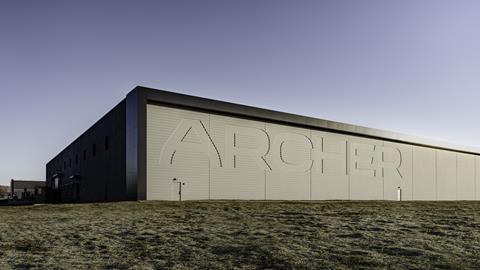A trio of leading US air taxi companies moved forward this week on plans to certificate, manufacture and commercialise a new class of electric aircraft.
Leading the charge was Joby Aviation, which said on 20 December that it has entered the final phase of certificating its electric vertical take-off and landing (eVTOL) aircraft with the Federal Aviation Administration.
Santa Cruz-based Joby said that recent type inspection authorisation (TIA) testing involved FAA pilots “evaluating human factors and safety using Joby’s simulator”, the start- up says.
The simulator incorporated an FAA-conforming flight deck, Joby says.
The start-up is targeting TIA flight testing in 2025, with its first FAA-conforming aircraft currently being assembled at its facility in Marina, California.
“As well as continuing the ‘for credit’ testing of components, aerostructures and systems that is already underway, we are targeting the start of TIA flight testing in 2025 with our first FAA-conforming aircraft, which is currently being built,” says chief executive JoeBen Bevirt.
Earlier this week, Joby said that it had completed for-credit static load testing on its aircraft’s tail structure, the first major aerostructure on Joby’s aircraft to receive the FAA’s blessing.
“This marks a significant step forward in the development of Joby’s electric air taxi, designed for high-speed, low-noise and zero-emission passenger service,” the company says.
Elsewhere in the air taxi segment, Santa Clara-based Archer Aviation completed a large-scale manufacturing facility in Covington, Georgia, where it plans to ramp production of its Midnight air taxi to hundreds of units annually through a partnership with automotive manufacturer Stellantis.

Archer recently received a certificate of occupancy for the 37,161sq m (400,000sq ft) building – which is called ARC – and has already begun loading tools into the facility. Initial production is expected to begin early next year, ramping to two aircraft monthly by the end of 2025 – and to a highly ambitious target of 650 annually by 2030.
”With ARC coming online and Stellantis by our side, we’re well-positioned to meet the global demand we‘re seeing for eVTOL aircraft,” CEO Adam Goldstein said in a post on networking platform LinkedIn.
Also this week, Vermont-based Beta Technologies secured a deposit-backed order – for two of the start-up’s Alia eVTOLs and options for another 10 – from New Zealand Air Ambulance Service, which plans to use the aircraft for patient-carrying operations beginning in 2028.
The deal marks the second New Zealand-based customer interested in operating Beta’s electric aircraft, following Air New Zealand’s multi-phase order for the conventional take-off and landing variant of Alia.
Beta says that the deal reflects “growing demand for the company’s charging infrastructure in the region”.
New Zealand Air Ambulance Service says that it plans to use eVTOL aircraft to “bridge the gap for rural and vulnerable communities”. The air taxis will “offer patient transfers at nearly half the cost of traditional rescue helicopters”.
In November, Beta flew the first Alia CX300 aircraft to roll off its 18,580sq m (200,000sq ft) production facility in Burlington.































